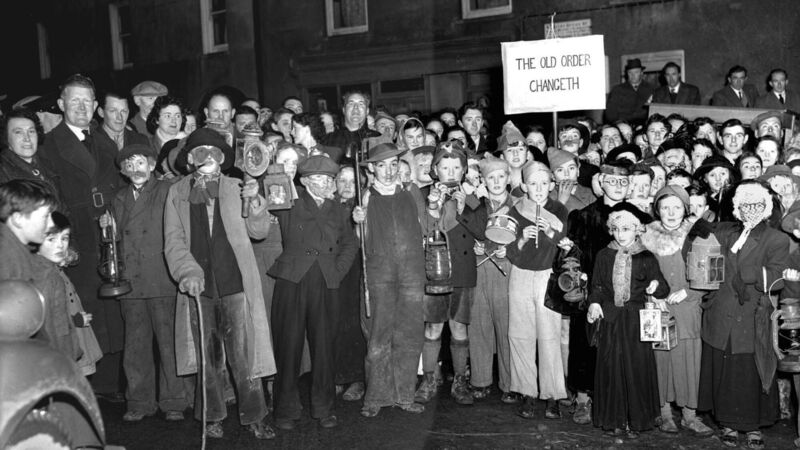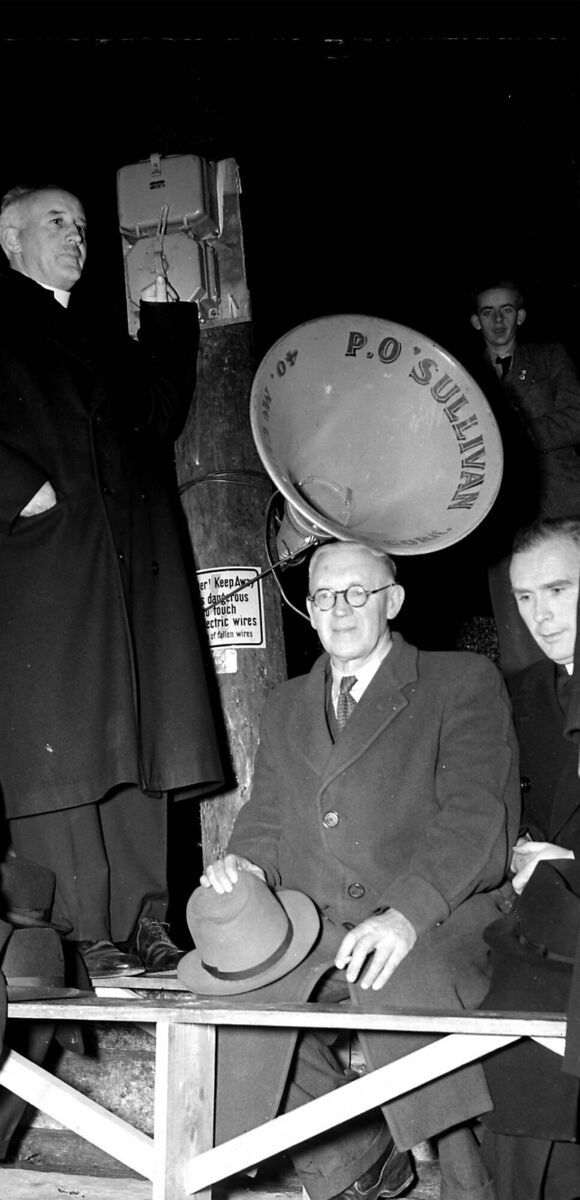Throwback Thursday: When power came to the people of Cork...

Crowds gather for the switching on of electricity in Killavullen village in North Cork in 1953
With all this discussion of childhood movie-going in recent editions of Throwback Thursday, what came back to my own mind quite suddenly was the memory that, once I got to having boyfriends, I was dragged to so many films I didn’t want to see at all!
All the delightful ones, like musicals and romance, you had to go to with girlfriends. Boyfriends always hauled you, protestingly, to dreadful horror ones, heavily gloomy ones, or (if they were UCC serious thinkers) art films that were both heavily gloomy and completely non-understandable.
Ballad Of A Soldier comes to mind, at the Palace, a long and depressing movie about a lad getting just a week’s leave to visit his ageing mother, and all the dangers and delays along the way, until at the end he only just has time to arrive, embrace her, and leave again for the front. Laugh a minute!
And, many years later, being literally forced into the cinema somewhere in England to see Jaws. I knew I wouldn’t like it, I was absolutely determined not to see it, but gosh, these males always think they know better.
“You’ll love it, you’ll love it, just wait until the girl is mauled to pieces, and when that man is dragged into those teeth, you can see the blood and hear him screaming…”, etc.
Still have nightmares over that one.
Correspondent Dermot Knowles laughed aloud when I mentioned this to him in passing.
“You are echoing my wife, because she reminds me of all the films I dragged her to because I ALWAYS decided what we would,” says Dermot.
“You see, when we were doing a line, I was (still am) a besotted film buff. Not the modern junk, more the classic Hollywood dream factory fare.
“As a child, when I stepped out of line, all my mother had to say was, ‘If you think you are going to the pictures next Saturday, you have another think coming’. That made me slip back into altar boy mode very quickly, believe me!”
It has got me wondering how many of you female readers were made to see movies you didn’t like at all? Come on here and tell the rest of us!
Dermot Knowles’ wife can hardly be the only one… And, come to that, did you really enjoy cowboy movies as much as the boys did? We might stake a small bet that you would have preferred The Student Prince.

Reader Michael Ryan has also been thoroughly enjoying the movie stories lately.
“Incidentally,” he adds, “I remember going to the Tech in Parnell Place where your dad taught me, Jo, and it was nice to see a photo of him in last week’s Throwback Thursday!
“Myself and another chap by the name of William would head to the pictures in the Savoy after the Tech finished. We would get in at one of the exit doors on one of the side streets. Can’t remember whether it was locked or not, but we managed it somehow.
“Once we were in, I remember crawling along on this bright red carpet up to the entrance door, then opening the door and sliding our way into the seats.
“We got away with this for ages, but eventually we were caught out,” says Michael.
“The film at the time was Willard, and we were totally engrossed in it when we were nabbed. It was about rats. I don’t know what rating was on it, probably 18. We were 14 at the time.”
The usher spotted the boys going to their seats with his flash-lamp, and Michael recalls: “He asked us for our tickets, and I quickly said ‘We’re after leaving them in the toilet’. He said: ‘Get out of here fast, or I will call the guards!’ So we skedaddled out of there.
“My favourite films were A Fistful Of Dollars, The Good, The Bad And The Ugly, The Magnificent Seven, eventually moving on to Bruce Lee films like Enter The Dragon, The Boss, The Way of the Dragon - just a few that spring to my mind.
“During my teenage days, we would meet up in The Grand Canyon and play the pinball machines. If you were lucky to get five balls down, I think it paid £1.50. That would give you the entrance fee to get into The Stardust nightclub, which was only seventy pence at the time.
“Another haunt of ours was The Tudor Rooms on Marlborough Street, where you could have nice cakes and tea.
“And I mustn’t forget The Regal Rooms, where you could play snooker. They had five or six tables if my memory serves me right.”
Michael moves on to another memory.
“Now, this year is the 40th anniversary of Live Aid,” he says, “and I don’t know if there is anything going to happen to commemorate it?
“Why I’ve brought this up is because a few weeks ago I was doing bit of clearing out in the attic, and came across a box of cassettes, ’90s tapes. There were seven of them in total.
“I remember that I had spent the day recording the artists, up to 2am or 3am in the morning. But I never got around to either playing the tapes or editing them. So I decided there and then that task would be done over the next few days.
“There were some interesting people speaking on audio, David Bowie in particular.”
Michael says of Live Aid in 1985: “In Ireland, we raised a million or more. There was a bicycle auctioned for £4,000, must have belonged to Stephen Roche, not sure.
“Readers are probably wondering why I didn’t record it on video. I don’t think they came out until the ’90s. I was wondering that myself, so I Googled it: the first videos were top loaders and had a price of £500-600, which was expensive at the time.
“Betamax were the first out. I had the privilege to mind one when relations of mine were on holidays. Playing Police Academy on it with Eddie Murphy!
“Ah, but we have so many gadgets today we don’t know what to do with ourselves!”
Another Throwback Thursday reader, Micheál Kenefick, has been recalling a time when non-urban dwellers didn’t even have the benefit of electric light, let alone video players.
“I’m not sure how many homes in the parish of Aghada had ‘the light’ before the Rural Electrification Scheme of 1946,” he says of his home-place. “But in any event, the electricity as we know it today was switched on for the first time on January 15, 1947.
“A generation of a certain vintage never used the word ‘electricity,’ as it had no relevance. Of huge relevance, however, and hence the name by which it became known was ‘the light’.
Someone might say, ‘I heard Cashmans are getting the light,’ or ‘I suppose we’d better sign up for the light’, they were common enough remarks in the late ’40s and early ’50s.”
Micheál continues: “The light was the wonder of the mid-20th century and would change our lives forever. The banshee was now dead and buried for evermore, and the Jack O the Lantern with her. The Bogey Man didn’t scare us so much any more, as all we had to do was turn on the light for a second and he was no longer a threat.
“The Headless Coachman got a quick shift also, since he couldn’t drive up the village as the light would call his bluff fairly lively.
“The light came to all of us in the country areas as a result of the Rural Electrification Scheme, which was a follow-on from the Shannon Scheme, which was in turn the brainchild of an Irish engineer, Thomas McLoughlin, who was working for the huge engineering firm of Siemens in Germany. He had a passionate interest in the development of the new Irish State and was the leading light (no pun intended) in persuading the government of the day to go ahead with the building of a dam in Ardnacrusha to harness the power of the Shannon to produce electricity.
“The courage of the government of the very young State must be recognised in the agreement to go ahead with this gigantic project in 1926.
“An idea of the enormity of the task almost 100 years ago can be gauged by a few facts from that era.
“Four new bridges needed to be built and nine new rivers created in the diversion.
“Some 7.5 million cubic metres of earth and 1.25 million cubic metres of rock had to be removed.
“Sixty miles of railway had to be built to cater for 130 steam locomotive trips; and during the construction, which was completed in 1929, there were 4,000 Irish and 1,000 German employees as Siemens got the go ahead to build the dam.
“The same Thomas McLoughlin was then appointed as Managing Director of Ireland’s first semi-state body (ESB) and was the driving force of the Rural Electrification Scheme, the first pole of which was erected in North Dublin on November 5, 1946, while the light only got to the beautiful Black Valley in Kerry in 1978.
“The country was divided into 792 areas which were roughly parishes, and an influencer (imagine that) was sought in each one, which was usually the Parish Priest, and regular preachings extolled the benefits of the light.”
Micheál adds: “Some households were unlucky, because if a neighbour on the line refused, then it would have been uneconomical to supply the electricity.
“Some of the reasons for refusal (as well as the fear of the thatch being burned), were:
No funds
House semi-derelict
Large family and couldn’t afford the fixed charge
Recently widowed
Both labourers out of work.
“But back to Aghada,” continues Micheál.
“The Aghada project commenced in December, 1950, and was completed in July, 1951. A total of 789 poles were erected during this window and the line requirement was slightly over 45 miles.
“The scale of this project can be judged by comparing it to the total numbers, which were almost two million poles and 50,000 miles of line.
“It is worth bearing in mind that the holes for the poles were six feet deep and were dug with the famous pick and shovel or, as it later became known, the biro with the long handle!”
Do we ever stop to think today about the vital part electricity plays in our lives? Street lighting, home lighting, power for the iron, the hairdryer, the washing machine, the cooker, and now, of course, the multiplicity of devices, gadgets, handhelds, computers, mobile phones?
(We won’t go there with the practicality of electric cars, since the jury will be out on that one for a few years yet.)
Thank-you for reminding us of this seismic change in our lives, Micheál.
Do you remember oil lamps and candles? Betamax? Let’s hear from you.
Email jokerrigan1@gmail.com, or leave a message on our Facebook page: www.facebook.com/echolivecork.







 App?
App?





